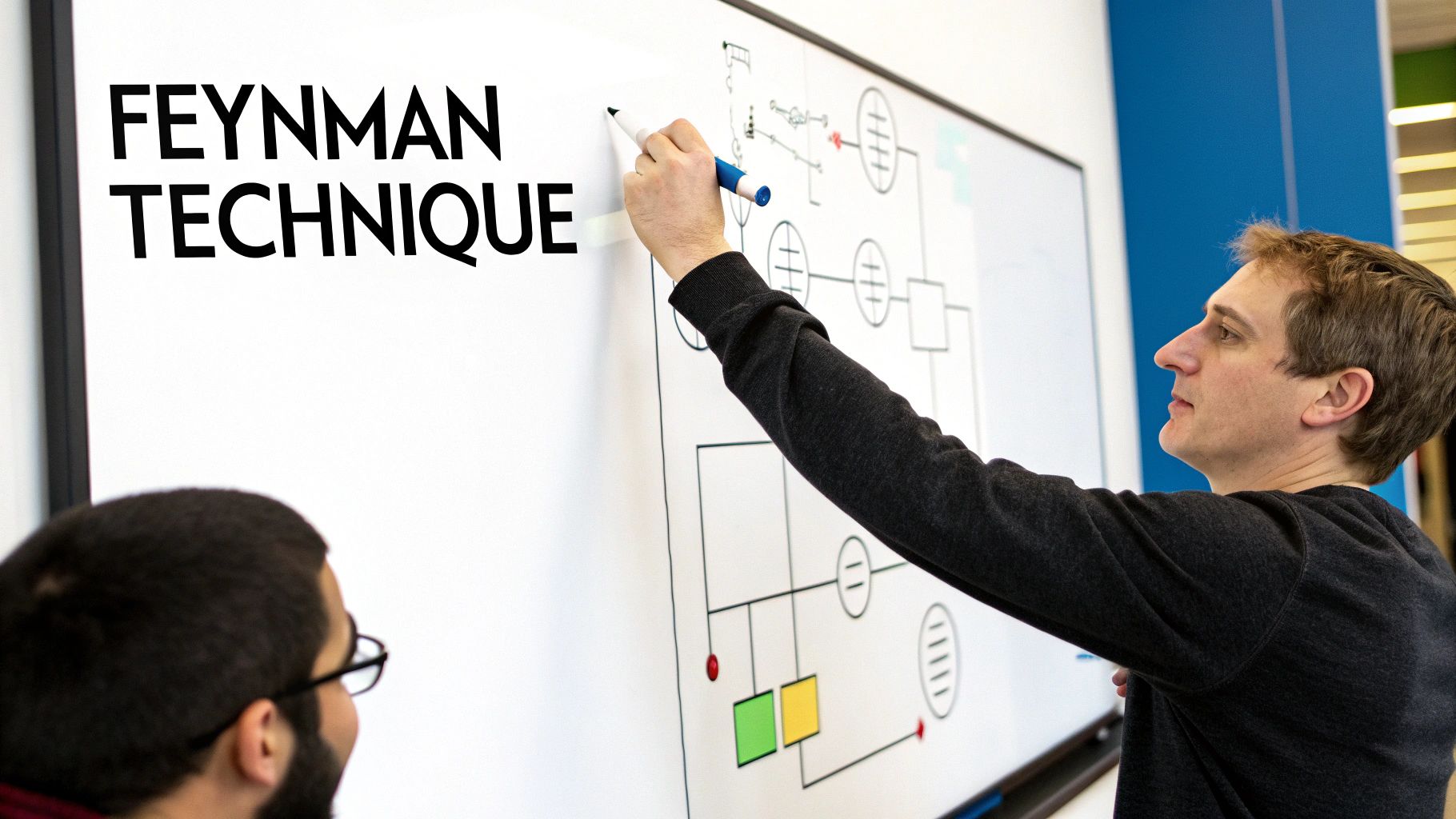In the quest for academic excellence, many students fall back on familiar yet ineffective habits: rereading textbooks until their eyes blur, covering pages in highlighter ink, and pulling stressful all-nighters. While these methods feel productive, cognitive science reveals they are among the least effective ways to learn. True academic success isn't about studying harder; it's about studying smarter. The difference lies in leveraging proven techniques that work with your brain's natural learning processes, not against them.
This guide moves beyond the conventional and often flawed advice to offer a toolkit of powerful, evidence-backed strategies. These aren't just minor adjustments; they are fundamental shifts in how you approach learning. We'll explore seven transformative tips for better studying, including Active Recall, the Pomodoro Technique, and Spaced Repetition, each designed to deepen your understanding and boost long-term retention. You will also discover how visual note-taking tools like TNote can amplify these methods.
By implementing these actionable techniques, you can make your study sessions dramatically more efficient and effective. Get ready to transform your study routine and unlock your full academic potential.
1. Active Recall
Active recall is a powerful study method that flips the traditional learning process on its head. Instead of passively absorbing information by rereading textbooks, highlighting notes, or watching lectures again, active recall forces your brain to actively retrieve information from memory. This process of pulling a fact, concept, or formula out of your brain is like exercising a muscle; the more you do it, the stronger the neural connection to that information becomes. This is a fundamental shift from recognition (seeing information and thinking, "I know that") to recall (producing information without any cues).

This technique, backed by decades of memory research, is one of the most efficient tips for better studying because it directly targets how our brains learn and store information for the long term. Constantly testing yourself reveals gaps in your knowledge, allowing you to focus your efforts where they are most needed, rather than wasting time reviewing material you already know well.
How to Implement Active Recall
Integrating active recall into your study routine is straightforward. The key is to create situations where you must generate answers yourself.
- The Blank Sheet Method: After studying a chapter or topic, close your book and grab a blank piece of paper. Write down everything you can remember about the topic, including key concepts, definitions, dates, and formulas. Afterward, compare your sheet to your notes to identify what you missed.
- Practice Questions: Work through problems at the end of a textbook chapter without looking at the solutions first. Create your own practice tests by turning headings and subheadings from your notes into questions.
- Flashcards (Digital or Physical): Use flashcards for discrete pieces of information like vocabulary words, historical dates, or scientific terms. Software like Anki uses spaced repetition, an advanced form of active recall, to show you cards at optimal intervals for memory reinforcement.
- Teach the Concept: Try explaining a topic to a friend, a family member, or even just to yourself out loud. This forces you to organize your thoughts and retrieve information in a coherent way, quickly exposing any areas of weakness in your understanding.
2. The Pomodoro Technique
The Pomodoro Technique is a time management method designed to combat mental fatigue and maintain high levels of focus. Developed by Francesco Cirillo in the late 1980s, this approach structures work into focused, timed intervals. Instead of attempting to study for hours on end, you break your sessions into 25-minute sprints of intense concentration, followed by a short 5-minute break. This cycle is repeated, and after four "Pomodoros," you reward yourself with a longer break of 15-30 minutes. This method leverages the brain's natural attention span, making it one of the most effective tips for better studying.

This technique works by creating a sense of urgency and preventing the burnout that often comes with long, unstructured study periods. By committing to just 25 minutes of focused effort, the task at hand feels less daunting, which helps overcome procrastination. The scheduled breaks are crucial for mental consolidation and rejuvenation, allowing you to return to your work refreshed and ready to concentrate again. It transforms studying from a marathon into a series of manageable sprints.
How to Implement the Pomodoro Technique
Incorporating the Pomodoro Technique is simple and requires little more than a timer and a commitment to the process. The goal is to create an environment of zero distractions for short bursts of time.
- Plan Your Tasks: Before starting, decide exactly what you will work on during your next Pomodoro session. This clarity prevents you from wasting your focused time figuring out what to do.
- Use a Dedicated Timer: A physical timer or a dedicated app (like Forest or Be Focused) works best. The act of setting a timer creates a psychological commitment to the session. During this 25-minute period, your only job is to focus on the planned task.
- Eliminate All Distractions: Turn off your phone notifications, close unnecessary browser tabs, and let others know you cannot be disturbed. The integrity of the 25-minute focus block is paramount.
- Respect the Breaks: Do not skip your breaks, even if you feel you are in a state of flow. Step away from your desk, stretch, get a glass of water, or do something completely unrelated to your studies. These breaks are essential for preventing mental exhaustion and maintaining productivity over multiple sessions.
3. Spaced Repetition
Spaced repetition is a powerful evidence-based learning technique that combats the natural human tendency to forget information. Instead of cramming material in one marathon session, this method involves reviewing what you've learned at strategic, increasing intervals over time. It works by interrupting the "forgetting curve," a concept identified by psychologist Hermann Ebbinghaus, which shows how memory fades. By reviewing information just as you are about to forget it, you reinforce the neural pathways, making the memory stronger and more durable.

This approach is one of the most efficient tips for better studying because it automates the review process, ensuring you spend time on material that needs reinforcing while not wasting effort on what you already know. This makes it ideal for subjects with a large volume of information to memorize, such as law, medicine, or language learning. Spaced repetition transforms studying from a brute-force activity into an intelligent, optimized process for long-term retention.
How to Implement Spaced Repetition
Integrating spaced repetition is most effectively done using specialized tools that handle the scheduling for you, but the principle can be applied manually as well.
- Use Digital SRS Tools: Software like Anki or Quizlet are purpose-built for spaced repetition. You create digital flashcards, and their algorithms automatically schedule when you need to review each card based on how well you remember it. This is the most popular and efficient method.
- The Leitner System (Manual Method): Use several physical boxes to sort your flashcards. Cards you get right move up to the next box (which you review less frequently), and cards you get wrong move back to the first box (for daily review).
- Review Daily, But Briefly: Consistency is crucial. Commit to a short review session each day, even just 10-15 minutes. The algorithm will only show you what’s necessary for that day, making it a manageable habit.
- Start Reviewing Early: Begin reviewing new material within 24 hours of learning it. This initial review is critical for moving information from short-term to long-term memory and setting the spaced repetition cycle in motion.
4. Feynman Technique
The Feynman Technique is a mental model for learning that prioritizes true comprehension over simple memorization. Named after Nobel laureate physicist Richard Feynman, this method challenges you to explain a concept in simple, plain language, as if you were teaching it to a complete novice. The core idea is that if you can't break down a complex topic into its fundamental components and explain it clearly, you don't truly understand it yet. This process forces you to confront the limits of your knowledge and identify precisely where your understanding is weak.

This approach is one of the most effective tips for better studying because it transforms passive learning into an active process of deconstruction and reconstruction. By simplifying complex ideas, you create stronger, more intuitive neural pathways. This technique is universally applicable, whether you're trying to grasp quantum mechanics, economic theories, or programming algorithms, making it a cornerstone of deep, lasting learning.
How to Implement the Feynman Technique
The process is a simple, four-step loop that you can integrate into any study session. The goal is to move from jargon-filled complexity to elegant simplicity.
- Step 1: Choose and Study a Concept: Select the topic you want to understand. Study it from your textbook, notes, or other resources until you have a basic grasp of the material.
- Step 2: Teach It to a Novice: On a blank piece of paper, write out an explanation of the concept as if you were teaching it to a child. Use simple language and avoid technical jargon. Using analogies from familiar, everyday experiences is particularly effective here. For example, explain cellular processes using a city metaphor or an algorithm using a cooking recipe.
- Step 3: Identify Your Gaps: As you write your explanation, you will inevitably get stuck or realize you are relying on vague terms. These are your knowledge gaps. This is the most crucial part of the process, as it pinpoints exactly what you need to review.
- Step 4: Review and Simplify: Go back to your source material to fill in your knowledge gaps. Once you have a better understanding, refine your explanation. Repeat the process until you can explain the concept completely and simply without getting stuck. Recording yourself explaining it can also reveal areas where your explanation is unclear.
5. Distributed Practice
Distributed practice, also known as the spacing effect, is a learning strategy that involves breaking up study sessions over time rather than cramming them all into one marathon session. Instead of pulling an all-nighter before an exam, you distribute that same amount of study time across multiple, shorter sessions spread over several days or weeks. This method directly combats the forgetting curve discovered by Hermann Ebbinghaus, leveraging how our brains consolidate memories more effectively when given time to rest and process information between learning intervals.
This approach is one of the most reliable tips for better studying because it builds robust, long-term memory. Each time you return to a topic after a break, you force your brain to retrieve the information again, strengthening the neural pathways. This leads to significantly better retention and deeper understanding compared to the stressful and inefficient process of last-minute cramming, which typically only supports short-term recall.
How to Implement Distributed Practice
The core principle of distributed practice is simple: study, wait, and review. You can integrate this into any study plan by being intentional about scheduling.
- Plan Your Sessions: Instead of studying for five hours the night before a test, plan five one-hour sessions spread across the week. Use a calendar or planner to block out these specific times to hold yourself accountable.
- Break Down Large Topics: Divide a large chapter or complex subject into smaller, manageable chunks. Dedicate one short session to each chunk, allowing you to focus deeply without feeling overwhelmed.
- Briefly Review First: Start each new study session with a quick 5-10 minute review of the material from the previous session. This act of retrieval warms up your brain and reinforces what you've already learned.
- Daily Doses of Learning: This method is perfect for subjects that require cumulative knowledge, like a new language or mathematics. A language learner might practice vocabulary for 15 minutes every day rather than for two hours only on Saturday. Similarly, a musician will see more progress practicing scales for 30 minutes daily than for three hours once a week.
6. Interleaving
Interleaving is a sophisticated learning strategy that challenges the conventional wisdom of studying one topic at a time. Instead of practicing a single skill or subject until mastery (known as "blocked practice"), interleaving involves mixing different, but related, topics or types of problems within a single study session. This constant switching forces your brain to work harder to identify the correct strategy for each problem, rather than just mindlessly applying the same solution over and over. This process of discrimination builds a more flexible and robust understanding of the material.
This approach, popularized by researchers like Robert Bjork and detailed in books like Make It Stick, is one of the most effective tips for better studying because it mirrors how knowledge is applied in the real world. Exams and real-life problems rarely present themselves in neat, predictable blocks. Interleaving prepares you to adapt, making your problem-solving skills more agile and enhancing long-term retention by forcing you to constantly retrieve different concepts and procedures.
How to Implement Interleaving
Adopting interleaving requires a shift in how you structure your study time. Instead of dedicating an entire session to one chapter, you’ll be pulling from several.
- Mix Problem Types: In a math study session, instead of doing 20 problems on the quadratic formula, do five quadratic formula problems, five on factoring, five on graphing parabolas, and five on completing the square. The jumbled order forces you to first identify the problem type before solving it.
- Vary the Subjects: For a history class, don't just study the American Revolution for an hour. Spend 20 minutes on the American Revolution, 20 on the French Revolution, and 20 on the Haitian Revolution. This helps you compare and contrast the causes and effects of each.
- Combine with Spaced Practice: Schedule your interleaved sessions over several days. On Monday, mix topics A, B, and C. On Wednesday, do it again. This combination of mixing topics and spacing out your practice is a powerful duo for long-term learning.
- Start Small: Begin by mixing two or three closely related concepts. As you become more comfortable, you can gradually increase the variety. It's important to have a foundational understanding of each topic before you start mixing them, otherwise the practice can become confusing rather than helpful.
7. Elaborative Interrogation
Elaborative interrogation is a powerful learning strategy that moves beyond simple memorization by prompting you to ask why things are the way they are. Instead of just accepting a fact, this technique requires you to actively generate explanations for it. This process of questioning and explaining creates a richer, more interconnected mental model of the subject matter, linking new information to your existing knowledge base and making it far more memorable.
This method forces your brain to dig deeper, forming stronger and more logical connections between concepts. Research, including work by cognitive psychologists like John Dunlosky, has highlighted its effectiveness. It transforms you from a passive recipient of information into an active participant in your learning, making it one of the most effective tips for better studying because it builds genuine understanding rather than surface-level familiarity.
How to Implement Elaborative Interrogation
To use this technique, you must cultivate a habit of curiosity and consistently probe the material you are studying. The goal is to generate explanations for facts and processes.
- Ask "Why" and "How": For any new fact or concept, pause and ask, "Why is this true?" or "How does this work?" For example, a history student might ask, "Why did this specific treaty lead to conflict later on?" A science student could ask, "How does this chemical reaction cause a change in color?"
- Connect to Prior Knowledge: Actively try to link the explanation to something you already know. This creates a strong anchor for the new information. For instance, when learning a new programming concept, you could ask, "How is this similar to a function I've used in another language?"
- Generate and Verify: Try to come up with your own explanation first before consulting your textbook or notes. Once you have a hypothesis, check it against the source material to confirm its accuracy and fill in any gaps in your reasoning.
- Explain Character or Company Actions: In subjects like literature or business, use this method to analyze motivations. Ask, "Why did this character make that decision?" or "Why did this company's strategy fail while a competitor's succeeded?" This deepens your analysis and critical thinking skills.
7 Effective Study Strategies Comparison
| Technique | Implementation Complexity 🔄 | Resource Requirements ⚡ | Expected Outcomes 📊 | Ideal Use Cases 💡 | Key Advantages ⭐ |
|---|---|---|---|---|---|
| Active Recall | Moderate - requires discipline and mental effort | Low - can be done with flashcards or apps | High - significantly improves long-term retention and confidence | Any subject, especially memorization-heavy fields | Strong memory retention; identifies knowledge gaps quickly |
| Pomodoro Technique | Low - simple timer-based cycles | Low - timer or app needed | Moderate - improves focus and reduces fatigue | Time management for study, coding, writing | Easy to implement; reduces procrastination |
| Spaced Repetition | Moderate - setup needed for scheduling reviews | Moderate - digital tools like Anki recommended | Very High - maximizes retention with minimal time | Memorization-heavy subjects, language learning | Efficient retention; automated review scheduling |
| Feynman Technique | High - time-intensive explanation process | Low - needs writing tools only | High - deep understanding and communication skills | Complex concepts requiring true comprehension | Reveals gaps; improves explanation skills |
| Distributed Practice | Moderate - requires consistent planning | Low - any schedule/calendar system | High - superior long-term retention | Long-term skill building, language learning | Reduces burnout; sustainable learning |
| Interleaving | Moderate - requires mixing topics thoughtfully | Low - no special tools needed | High - enhances problem-solving and flexible thinking | Subjects with varied problem types (math, sports) | Improves discrimination; reduces overconfidence |
| Elaborative Interrogation | Moderate - question-generation needed | Low - only questioning mindset required | Moderate - improves comprehension and critical thinking | Conceptual subjects needing deep understanding | Enhances critical thinking; builds stronger associations |
From Theory to Practice: Building Your Ultimate Study System
Throughout this guide, we have journeyed beyond surface-level advice, exploring a powerful arsenal of evidence-based strategies. From the focused time management of the Pomodoro Technique to the deep conceptual understanding fostered by the Feynman Technique, we've uncovered the science behind effective learning. The central theme connecting all these tips for better studying is a fundamental shift in perspective: learning is not a passive act of information absorption but an active, dynamic process of engagement.
The most successful students recognize that there is no single magic bullet for academic success. Instead, they become architects of their own learning, building a personalized and adaptable system. True mastery lies in understanding how to combine these techniques into a cohesive workflow that suits your unique needs, subjects, and schedule. It’s about moving from theory to consistent, deliberate practice.
Synthesizing Your Personal Study Framework
Imagine creating a study session where multiple strategies work in harmony. You could begin by using the Pomodoro Technique to structure your time into focused, 25-minute sprints, ensuring you remain engaged without burning out. Within each sprint, you might apply Active Recall, using flashcards or practice questions to pull information from your memory rather than passively reviewing it.
For complex topics, the Feynman Technique becomes your tool for deconstruction, forcing you to explain the material in simple terms as if teaching a beginner. When planning your week, you’ll use Distributed Practice and Spaced Repetition to schedule these review sessions, ensuring long-term retention by revisiting information at optimal intervals. Finally, by practicing Interleaving- mixing different but related topics- you build mental agility and deepen your understanding of how concepts connect. This integrated approach transforms studying from a daunting task into a manageable and highly effective skill.
Your Action Plan for Smarter Studying
The journey to becoming an efficient learner starts with a single step. Don't try to implement all seven methods at once. Instead, choose one or two that resonate most with you and commit to trying them for the next week.
- Start Small: Perhaps begin with the Pomodoro Technique to improve your focus or Active Recall to make your reviews more productive.
- Observe and Adapt: Pay close attention to the results. Do you feel more focused? Is information sticking better? Use this feedback to refine your approach.
- Build Incrementally: Once you're comfortable, integrate another technique into your routine. Over time, you will have built a robust, custom-tailored system that maximizes your efforts.
By embracing these tips for better studying, you are not just aiming for better grades; you are investing in a lifelong skill. The ability to learn effectively and efficiently will serve you in your academic career, your professional life, and any personal pursuits you undertake. You are learning how to learn, a meta-skill that unlocks your full potential.
Ready to put these strategies into action? Transform your notes from static text into dynamic, visual knowledge cards with TNote. Our platform is designed to help you apply the Feynman Technique and Spaced Repetition effortlessly, turning complex information into memorable insights. Start building your ultimate study system today at TNote.